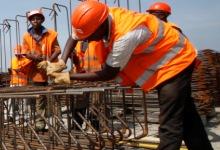
Typical street scene in Santa Ana, El Salvador. (Photo: iStock)
IMF Survey : Sustain Africa’s Growth by Easing Structural Bottlenecks
October 11, 2014
- Sub-Saharan Africa set to grow by 5 percent in 2014, 5 ¾ percent in 2015
- Region projected to remain second fastest–growing in the world
- Ebola outbreak causing human suffering, negative economic spillovers
Sustaining growth in sub-Saharan Africa requires proactively addressing structural bottlenecks to growth such as infrastructure gaps and poor business climates, IMF African Department Director Antoinette Sayeh said.

Bridge site in Abidjan, Cote d’Ivoire: goal is balance between infrastructure spending, public debt buildup (photo: Thierry Gouegnon/Reuters/Corbis)
2014 IMF–WORLD BANK ANNUAL MEETINGS
She told an October 10 news conference at the 2014 IMF-World Bank Annual Meetings that avoiding the emergence of macroeconomic imbalances such as excessive fiscal and external current account deficits would also underpin expansion.
“The challenge will be striking the right balance between scaling up investment in infrastructure and other development objectives while avoiding an unsustainable public debt buildup,” Sayeh told reporters.
She said the underlying picture for sub-Saharan Africa remains favorable, with the region’s economy expected to expand by 5 percent in 2014 and 5 ¾ percent in 2015. Sayeh noted that most sub-Saharan African economies are enjoying strong growth, driven by investment in infrastructure, buoyant services sectors, and strong agricultural production.
“Overall, sub-Saharan Africa is expected to continue being the second fastest–growing region in the world, just behind emerging and developing Asia,” Sayeh said. But she added that this positive outlook coexists with a dire situation in Guinea, Liberia, and Sierra Leone, where the Ebola outbreak continues to spread unabated.
Ebola’s effects
“Beyond the unbearable number of deaths, suffering, and social dislocation that it is causing, it is also causing extensive damage to the economies and institutions of these three already fragile countries,” Sayeh declared. Even with the disease limited to these three countries, there are tangible negative economic spillovers on neighboring countries.
She said that heavily tourist–reliant The Gambia and, to a lesser extent, Senegal have seen a large number of booking cancelations, and some other regional transportation hubs such as Ghana and Kenya may also see transitory declines in airline and hotel activity.
Sayeh also pointed to a small number of countries where economic activity is facing headwinds from homegrown policy challenges. For instance, in South Africa, growth remains lackluster due to electricity bottlenecks, weak product market competitiveness, and difficult industrial relations. In a few other countries, including Ghana, and until recently Zambia, large macroeconomic imbalances have resulted in pressures on the exchange rate and inflation.
Sustain growth, foster inclusion
Against this backdrop, most African countries’ policymakers should focus on sustaining growth and policies to make growth more inclusive, Sayeh said,. In particular
• Addressing structural bottlenecks to growth such as infrastructure gaps and poor business climates, as well as avoiding macroeconomic imbalances such as excessive fiscal and external account deficits.
• Sustaining growth is a necessary condition to foster job creation and reduce poverty. But growth is not always a sufficient condition for inclusiveness, and should be supported by social safety nets, better targeting of public services, and investment in worse-off regions.
More financing to fight Ebola
In the countries currently being affected by the Ebola outbreak, fiscal deficits need to widen to enable the countries to accommodate higher Ebola-related spending and to help avoid an even more pronounced decline in economic activity. The main constraint on allowing fiscal deficits to widen in these countries is financing.
Sayeh noted that the IMF Board recently approved some $130 million in additional financial assistance for Guinea, Liberia, and Sierra Leone. “But there remain further significant financing gaps both for the rest of 2014 and for 2015, and additional support from both bilateral and multilateral creditors will be important to assist these countries,” Sayeh stated.
Responding to questions, Sayeh stressed that the IMF’s financial assistance to the three Ebola-affected countries is interest free and covers a considerable amount of the countries’ combined financing gap of around $300 million, which may need to be revised in light of changing circumstances.
However, noting that the IMF’s concessional financing comprises loans, not grants, Sayeh added “The first best solution for countries facing shocks like Ebola, and the huge humanitarian devastation that it causes, is significant grant financing from the donor and partner community.”
Market financing
Welcoming sub-Saharan African countries’ increased access to international capital markets through recent sovereign debt issuance, Sayeh said such borrowing signaled increased interest in the region by investors, stressed the region’s progress in implementing better macroeconomic policies, helped countries diversify their financing sources, and stimulated debt issuance by the private sector.
But she stressed that countries have to be prudent in how they take advantage of bond issuance, and allow for the obligations of bullet repayments and for exchange risk, while also putting sovereign bond proceeds to good use through high-quality investments that will help finance subsequent repayment.
On the broader issue of public borrowing, Sayeh observed that the IMF hoped to present a revised debt limits policy to its Executive Board soon after the Annual Meetings. This would, she said, be important in allowing countries more flexibility in striking a balance between scaling up infrastructure and maintaining debt sustainability.
Rebase more often
Sayeh also hailed regional countries’ ongoing efforts to rebase their GDP, but urged authorities to rebase more frequently. “Typically, some countries have had 20 years or more pass before updating the surveys that feed their GDP estimates. The best practice in this area is for countries to try to rebase every five years.”
Acknowledging the expense and complexity of surveys to update GDP, she emphasized that statistics work needed more support from donors and from national authorities, as government statistical agencies were often deprived of resources. Sayeh also noted that IMF regional technical assistance centers included long-term statistical advisors.
â– The IMF’s Regional Economic Outlook for Sub-Saharan Africa will be released October 20, 2014.


